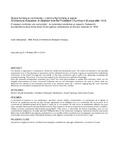Mostrar o rexistro simple do ítem
El espacio conforma una comunidad, la comunidad conforma un espacio: evaluación arquitectónica de la forma ideal de las iglesias protestantes en Europa después de 1918
| dc.contributor.author | Vukoszávlyev, Zorán | |
| dc.date.accessioned | 2019-05-31T07:44:25Z | |
| dc.date.available | 2019-05-31T07:44:25Z | |
| dc.date.issued | 2017 | |
| dc.identifier.citation | Vukoszávlyev, Z. (2018). El espacio conforma una comunidad, la comunidad conforma un espacio. Actas De Arquitectura Religiosa Contemporánea, 5, 26-51. https://doi.org/10.17979/aarc.2017.5.0.5141 | es_ES |
| dc.identifier.issn | 2340-5503 | |
| dc.identifier.uri | http://hdl.handle.net/2183/23098 | |
| dc.description.abstract | [Resumen] La identidad se expresa en una autoimagen, que tiene marcas visibles e inmateriales. La arquitectura de la iglesia es la forma de apariencia esencial de esto, porque representa no al individuo sino a la comunidad. Da un recuento de la conciencia de identidad propia de la iglesia a través de la comunidad. De esta forma, la arquitectura obtiene una gran tarea: visualizar físicamente esta identidad inmaterial. Esta imagen se forma con respecto al conocimiento técnico y estético. ¿Existe la forma protestante básicamente reconocible? ¿Hay planos o elementos de formas espaciales, que son las características obligatorias de estas iglesias? Reflejado bien en las cuestiones teológicas, buscamos detectar qué puede determinar la identidad de las iglesias protestantes en un sentido estético mediante una investigación que destaca las más importantes decesiones sobre el trasfondo teológico y las iglesias construidas en el término de un siglo. | es_ES |
| dc.description.abstract | [Abstract] The identity is expressed in a self-picture, which has visible and immaterial marks. The church architecture is the essential appearance form of this, because it represents not the individual but the community. It gives an account of the self-identity conscience of the church through the community. In this way, architecture gets a great task: physically visualising this immaterial identity. This picture is formed with respect to the technical and aesthetic knowledge. Does the basically recognizable protestant form exist? Are there ground-plans or spatial form elements, which are the obligate characteristics of these churches? Reflected well on the theological questions, we seek to detect what can determine the identity of the protestant churches in an aesthetic sense by a research highlighting the most important decesions on theological background and churches built in a term of a century | es_ES |
| dc.language.iso | eng | es_ES |
| dc.publisher | Universidade da Coruña | es_ES |
| dc.relation.uri | https://doi.org/10.17979/aarc.2017.5.0.5141 | es_ES |
| dc.rights | Atribución-NoComercial 4.0 España | es_ES |
| dc.rights.uri | http://creativecommons.org/licenses/by-nc/3.0/es/ | * |
| dc.subject | Arquitectura religiosa moderna | es_ES |
| dc.subject | Fundamentos teológicos protestantes | es_ES |
| dc.subject | Tipología eclesiástica | es_ES |
| dc.subject | Comunidad | es_ES |
| dc.subject | Europa | es_ES |
| dc.subject | Modern Church Architecture | es_ES |
| dc.subject | Protestant theological fundaments | es_ES |
| dc.subject | Church typology | es_ES |
| dc.subject | Community | es_ES |
| dc.subject | Europe | es_ES |
| dc.title | El espacio conforma una comunidad, la comunidad conforma un espacio: evaluación arquitectónica de la forma ideal de las iglesias protestantes en Europa después de 1918 | es_ES |
| dc.title.alternative | Space forming a community – community forming a space: Architectural evaluation of idealized form for Protestant Churches in Europe after 1918 | es_ES |
| dc.type | info:eu-repo/semantics/article | es_ES |
| dc.rights.access | info:eu-repo/semantics/openAccess | es_ES |
| UDC.journalTitle | Actas de Arquitectura Religiosa Contemporánea | es_ES |
| UDC.volume | 5 | es_ES |
| UDC.startPage | 26 | es_ES |
| UDC.endPage | 51 | es_ES |






